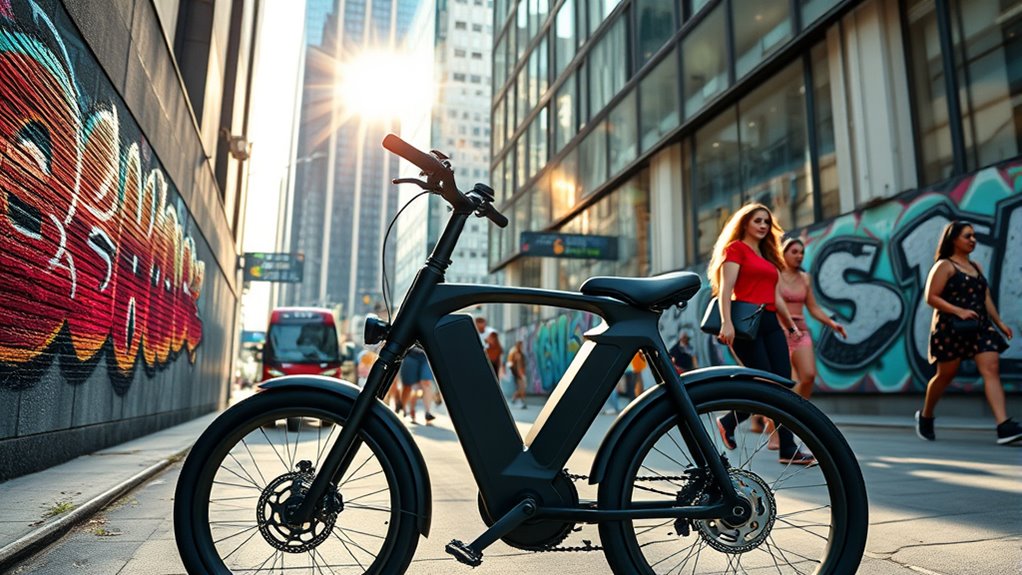E-bikes are transforming urban mobility by providing a faster, eco-friendly way to navigate city streets. They help you avoid traffic, reduce pollution, and save money on fuel and parking. With advancements in batteries and supportive infrastructure like dedicated lanes and charging stations, more people are turning to e-bikes for daily travel. If you keep exploring, you’ll discover how these innovations are shaping a cleaner, more efficient future for city commuting.
Key Takeaways
- E-bikes significantly reduce urban traffic congestion and emissions by replacing car trips and promoting eco-friendly transportation.
- Advances in battery tech and smart features enhance e-bike efficiency, safety, and user experience, boosting adoption worldwide.
- Infrastructure development like dedicated lanes and charging stations facilitates seamless integration into urban mobility systems.
- Government incentives and policies support e-bike growth, encouraging sustainable commuting and urban planning initiatives.
- E-bikes improve commutes by offering longer, faster, and more affordable travel options, transforming city transportation landscapes.
The Growing Popularity of E-Bikes Worldwide
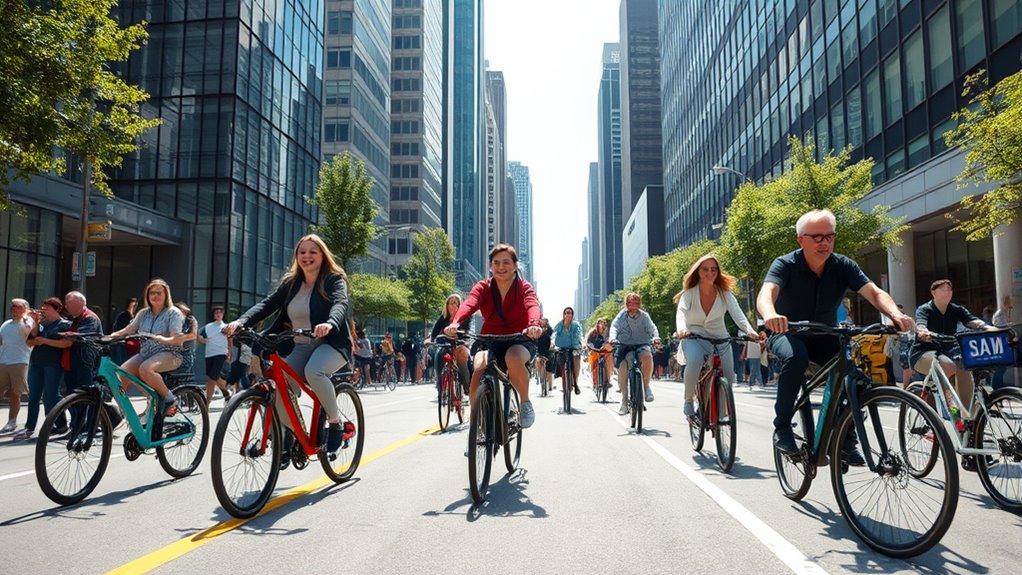
The popularity of e-bikes is soaring worldwide as more people seek sustainable and efficient transportation options. E-bike adoption is fueling urban mobility and contributing markedly to sustainable transportation efforts. Market growth is evident, with global e-bike sales jumping from 0.5 million units in 2009 to over 5.1 million in 2021. Countries like Switzerland, the Netherlands, and Germany lead in e-bike usage, showcasing how electric bikes are transforming daily commutes. In Australia, rising e-bike sales reflect a shift toward eco-friendly travel amid congestion and pollution concerns. Even in African nations like Togo, Benin, and Rwanda, local companies and international funding are promoting e-bike adoption. Overall, worldwide e-bike popularity underscores their role in creating cleaner, greener urban environments. Additionally, innovations in battery technology are enhancing e-bike performance and range, further boosting consumer confidence and adoption. Advances in sustainable materials are also contributing to making e-bikes more environmentally friendly and affordable for a broader audience. Moreover, the integration of smart technology is improving user experience and safety. Furthermore, public awareness campaigns are playing a significant role in encouraging more people to consider e-bikes as a practical transportation option. As the industry continues to innovate, regulatory frameworks are being developed to ensure safety standards and promote sustainable growth in e-bike markets worldwide.
Key Benefits for Urban Commuters
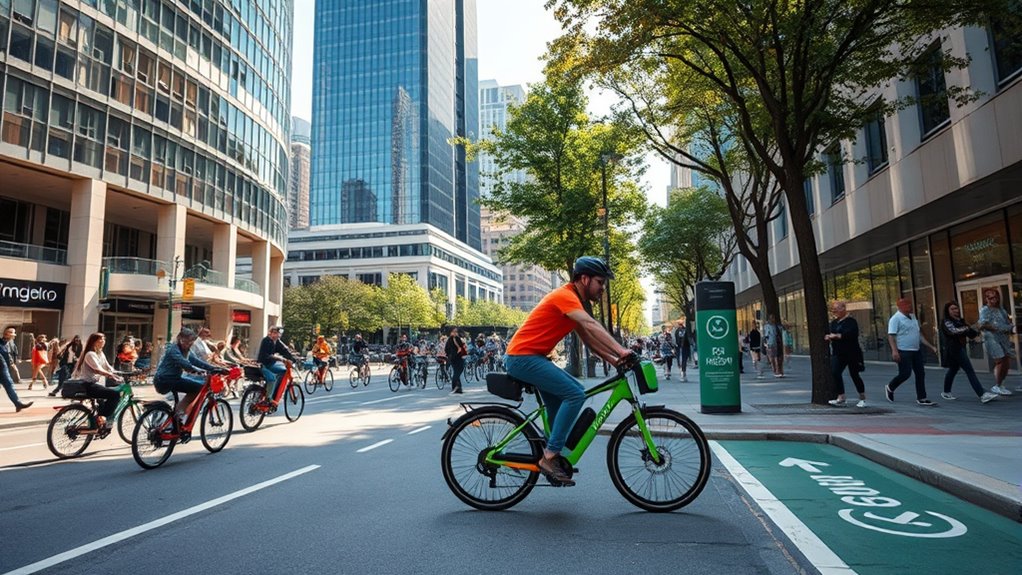
E-bikes offer urban commuters a practical way to cover longer distances with less physical effort, making daily travel more manageable and efficient. With electric bikes, you can navigate city streets more quickly by bypassing congestion and making use of cycling infrastructure. They improve urban mobility by helping you reach your destination faster, especially during peak hours. Using e-bikes reduces carbon emissions by replacing short car trips, supporting cleaner city air. Additionally, they provide significant cost savings on fuel, parking, and maintenance, making them a budget-friendly choice. The electric assistance makes tackling hills and headwinds easier, increasing comfort and reliability. Moreover, implementing dynamic communication exercises can foster better understanding and cooperation among commuters and city planners alike. Furthermore, choosing the right vacuums for pet hair can help maintain a clean environment in your home, complementing your eco-friendly lifestyle. In addition, proper Kia Tuning can enhance vehicle performance and efficiency, aligning with the goals of sustainable urban transportation. Incorporating installation knowledge from small wood stove guidelines ensures safety and efficiency in home heating solutions. Overall, e-bikes empower commuters to enjoy faster, greener, and more affordable urban transportation options.
How E-Bikes Help Reduce Environmental Impact

E-bikes help cut down your carbon footprint by replacing car trips, reducing greenhouse gas emissions in cities. They also ease traffic congestion and lower noise pollution, making urban areas more livable. Plus, recharging e-bikes with renewable energy sources further minimizes their environmental impact. Incorporating sustainable practices like this can amplify the positive effects on our environment. Additionally, utilizing clean energy sources for recharging can significantly increase their eco-friendly benefits. Implementing environmentally responsible charging methods and promoting awareness about their importance can further support sustainable urban mobility, especially when combined with aesthetic wall organization solutions that encourage a more organized and eco-conscious living space.
Lower Carbon Emissions
By replacing car trips with e-bike rides, urban commuters can markedly cut down their carbon footprint, often reducing emissions by up to 90% on short journeys. Electric bikes are a key part of reducing urban pollution and promoting eco-friendly transportation. They consume less energy per trip, especially when charged with renewable sources, profoundly lowering greenhouse gas emissions. This shift supports sustainable mobility by decreasing reliance on fossil fuel-powered vehicles, which are major contributors to urban air pollution. Cities like Wellington and Christchurch have seen substantial reductions in greenhouse gases as more people adopt e-bikes for their daily commutes. Widespread use of electric bikes in Europe further demonstrates their power to lower city-wide carbon emissions, helping cities achieve cleaner, healthier environments. Additionally, understanding market trends and investment strategies can accelerate the adoption of e-bikes as a sustainable transport solution. Incorporating energy-efficient charging methods can further enhance their environmental benefits by reducing overall energy consumption.
Reduced Traffic Congestion
As urban areas become more crowded, replacing short car trips with e-bikes can substantially ease traffic congestion. E-bikes help reduce the number of vehicles on the road, improving urban mobility during peak hours. With dedicated bike lanes, riding an e-bike becomes faster and safer, encouraging more people to choose this sustainable transportation option. As more riders opt for e-bikes, the overall vehicle miles traveled decrease, leading to fewer emissions and less congestion. Cities with high e-bike adoption have reported significant reductions in traffic jams, especially in congested areas. By shifting short trips from cars to e-bikes, you contribute to smoother traffic flow and a cleaner environment, making cities more livable and efficient for everyone. Additionally, promoting alternative transportation options like e-bikes can foster a shift toward more sustainable urban mobility strategies. Incorporating e-bike infrastructure such as charging stations and secure parking can further support this transition and enhance the benefits of e-bike usage. Developing comprehensive urban mobility plans that prioritize cycling and other eco-friendly transit methods can help sustain these positive impacts over time. Proper bike maintenance and regular checks can ensure safe and efficient e-bike operation, encouraging more widespread adoption. Furthermore, integrating growing urban cycling culture initiatives can increase community engagement and support for e-bike programs, leading to long-term benefits.
Promoting Renewable Energy
Reducing traffic congestion is a significant step toward cleaner cities, but maximizing environmental benefits requires a focus on how e-bikes are charged. By using renewable energy for e-bike charging, you further cut emissions and support sustainable urban mobility. Charging with green energy sources like solar power enhances decarbonization efforts, making e-bikes an eco-friendly transportation option. As the global shift toward renewable electricity progresses, the environmental impact of e-bike use diminishes even more. This progression helps create healthier cities with less air pollution. To maximize these benefits, consider these ideas:
- Charging e-bikes with solar or wind power
- Supporting policies for renewable energy infrastructure
- Encouraging home-based green energy solutions
- Promoting e-bike use in areas with clean electricity grids
- Contributing to decarbonization goals through sustainable practices
- Engaging with hackathons and innovative communities to explore new solutions for sustainable urban mobility
Changes in Urban Infrastructure Supporting E-Bikes
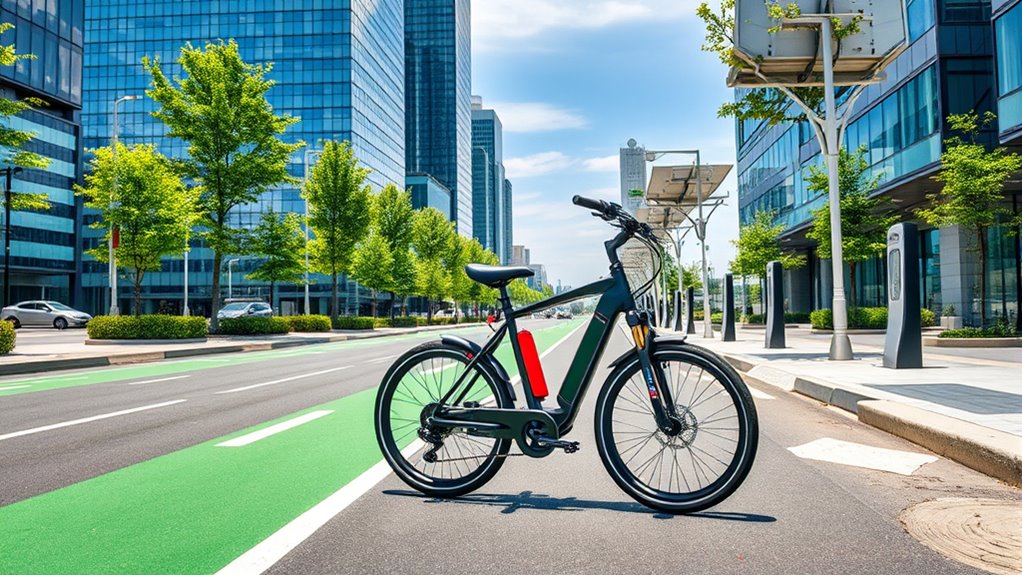
Cities around the world are actively upgrading their urban infrastructure to better support e-bike use. You’ll notice expanded bike lanes and protected cycling infrastructure, making riding safer and more convenient. Infrastructure upgrades now include charging stations and battery swap hubs along major routes, boosting e-bike accessibility. Some cities are installing solar-powered charging stations and smart traffic management systems that prioritize cyclists, enhancing safety and efficiency. Urban planning efforts focus on cycling-friendly development, with clear signage and designated e-bike zones that reduce conflicts with pedestrians and vehicles. Data shows that these infrastructure improvements have led to a 35% rise in e-bike adoption, demonstrating how thoughtful investments in cycling infrastructure can transform urban mobility and encourage more sustainable transport choices.
Challenges and Opportunities in E-Bike Adoption
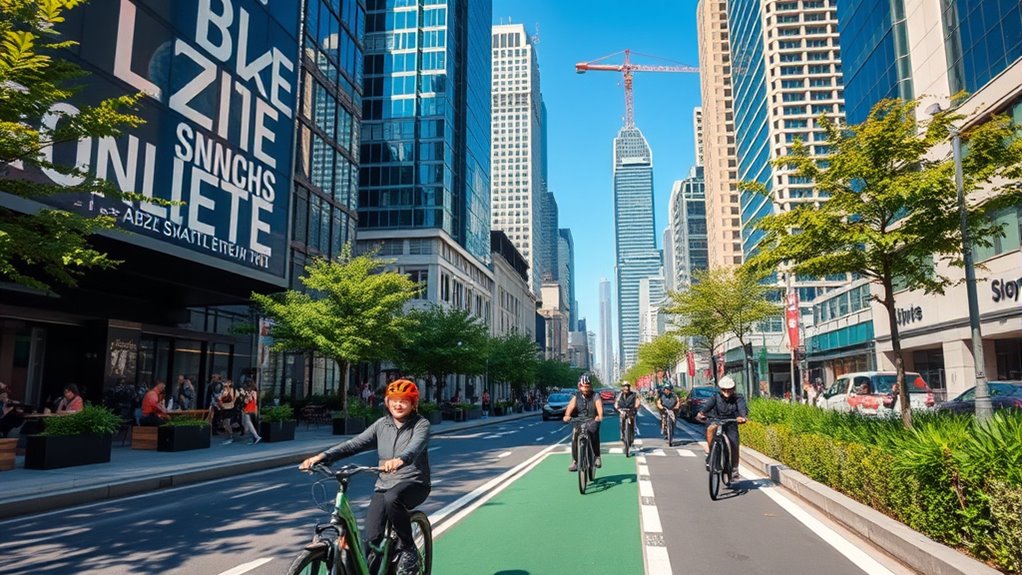
As you consider expanding e-bike use, regulatory frameworks and standards play a crucial role in shaping adoption and safety. Infrastructure development must address charging needs and dedicated bike lanes to reduce risks and encourage riders. Promoting rider safety through education and clear policies can help overcome barriers and enable the full potential of e-bikes in urban mobility.
Regulatory Frameworks and Standards
Establishing clear regulations and standards for e-bikes is essential to guarantee rider safety and promote consistent use across regions. Without well-defined legal frameworks, riders face confusion, and enforcement becomes challenging, hindering e-bike adoption. Proper regulation of e-bike classifications, speed limits, and motor power ensures safety standards are met, reducing accidents. Developing infrastructure guidelines for charging and parking supports widespread integration. Implementing safety standards for manufacturing, including crashworthiness and lighting, further enhances rider visibility and protection. Regulatory efforts that include licensing, insurance, and rider education foster safer urban mobility.
- E-bike classifications and speed limits
- Safety standards for manufacturing
- Infrastructure guidelines for charging
- Legal frameworks and licensing
- Rider safety and education
Infrastructure Development Needs
Developing dedicated bike lanes and charging stations is essential for supporting e-bike adoption, as these infrastructures directly impact rider safety and convenience. Well-designed bike lanes, protected cycling paths, and micro-mobility zones encourage more people to choose e-bikes by providing safer, accessible routes. Addressing infrastructure gaps, like insufficient charging infrastructure and limited bike parking, is critical to integrating e-bikes into urban transportation systems. Urban areas with strategic investments in these areas see higher e-bike usage rates, highlighting the importance of infrastructure development. While funding and stakeholder coordination pose challenges, opportunities exist through public-private partnerships and policy incentives. Prioritizing infrastructure growth enhances safety, reduces accidents, and promotes widespread e-bike adoption, transforming urban mobility for the better.
Promoting Rider Safety
While expanding infrastructure like dedicated bike lanes and charging stations addresses some barriers to e-bike adoption, rider safety remains a noteworthy concern. Higher risks of head injuries and fractures arise from inconsistent helmet use and rider inexperience. Without proper safety training, accidents are more likely, especially in areas lacking clear signage and protected lanes. Implementing traffic regulations such as speed limits and geofencing helps reduce crashes and sidewalk obstructions. Opportunities to improve safety include targeted safety campaigns, rider education programs, and stricter enforcement of helmet use. Prioritizing accident prevention through infrastructure upgrades and safety training can considerably lower injury rates. Ensuring riders are well-informed about traffic regulations and safety practices promotes safer urban mobility and encourages responsible e-bike use.
- Helmet use promotion
- Safety training programs
- Dedicated infrastructure improvements
- Traffic regulation enforcement
- Safety campaigns and awareness
Future Trends Shaping the E-Bike Market
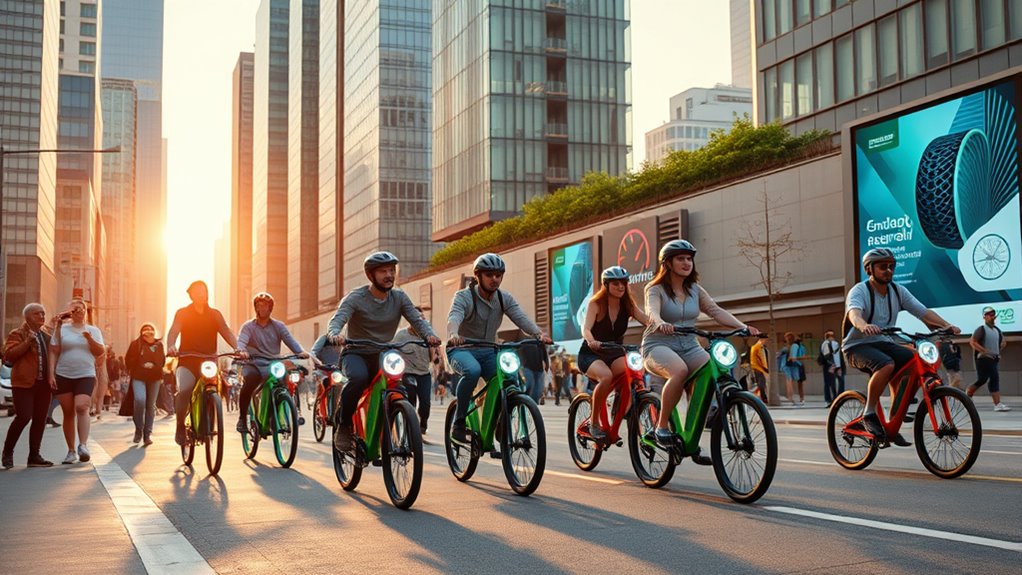
The future of the e-bike market is being shaped by rapid technological innovations and supportive policy measures. Expect advancements like better batteries offering longer range, faster charging, and lighter materials that improve performance. Smart features such as GPS, app controls, and anti-theft systems are becoming standard, enhancing your riding experience and security. Governments worldwide are increasing incentives, subsidies, and tightening emission regulations, which boost e-bike adoption—especially in Europe and Asia. Infrastructure development is also accelerating, with more charging stations and dedicated bike lanes supporting market growth. These future trends align with urban sustainability goals, making e-bikes an even more practical, eco-friendly transportation choice. Together, these factors will drive continued growth and innovation in the e-bike market.
Frequently Asked Questions
Why Are E-Bikes Becoming so Popular?
You notice e-bikes becoming popular because they offer a convenient, eco-friendly way to get around. With advances in battery tech and lower prices, more people can afford them. They help reduce traffic congestion, cut pollution, and make short commutes easier. Plus, governments support their use through incentives. As a result, you see e-bikes as a smart, sustainable choice for urban travel, gaining widespread appeal worldwide.
When Did E-Bikes Become Popular?
You might wonder when e-bikes became popular. Around 2010, their popularity started rising in Europe, thanks to better batteries and lightweight motors. By 2015, cities like Amsterdam saw a surge, especially with improved cycling infrastructure. The COVID-19 pandemic in 2020 further boosted sales globally. Government incentives and environmental concerns also played a role, making e-bikes a preferred eco-friendly transportation option over the past decade.
What Is the Trend in the E-Bike Industry?
So, you’re wondering about the e-bike industry’s trend? Well, it’s booming at over 11% CAGR, making it hard to ignore. You’ll see more sleek, smart models, and countries like Switzerland and China lead the way, all thanks to better tech and eco-conscious cities. Ironically, as traffic worsens, more people hop on e-bikes for a quick, green escape. It’s a revolution you might want to pedal into!
What Is the Growth of E-Bikes?
You’ll see that e-bike growth is remarkable, with global sales soaring from 1.2 million in 2009 to over 5.1 million in 2021. In countries like Switzerland and across Europe, sales are increasing rapidly, supported by urban mobility needs and incentives. You can expect this trend to continue, with annual growth rates of around 8-10%, making e-bikes a significant part of future transportation.
Conclusion
Imagine your city as a bustling river, and e-bikes are the swift, eco-friendly boats guiding you smoothly through the currents. As more of these vessels take to the water, traffic jams and pollution fade into the background. By embracing e-bikes, you become part of this vibrant flow, transforming urban life into a cleaner, more efficient voyage. The future’s in your hands—ready to steer toward a smarter, greener city?
